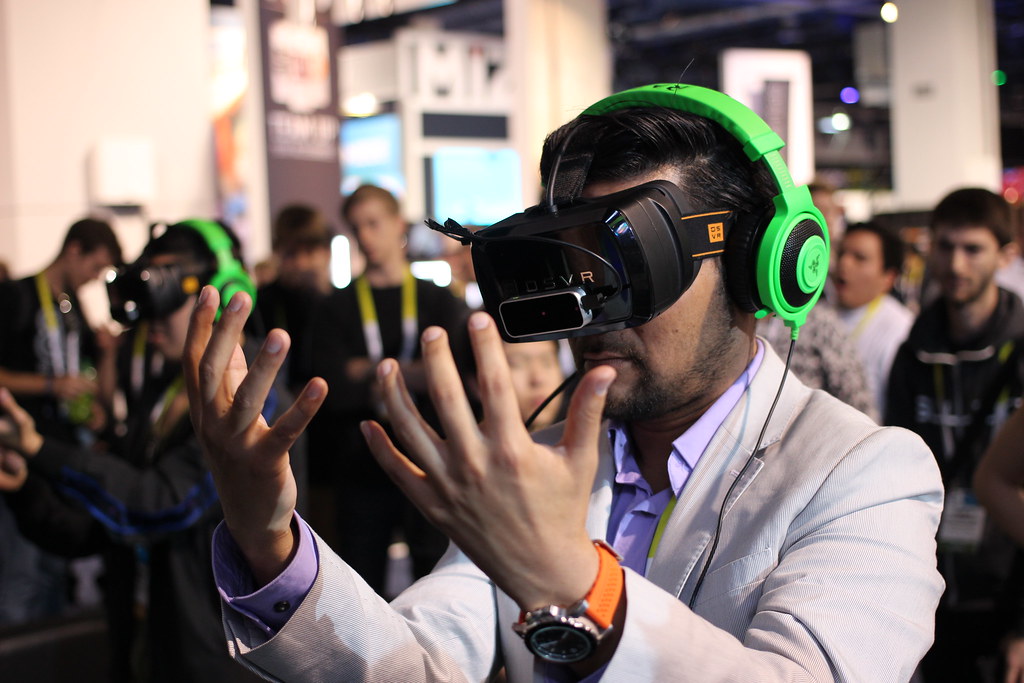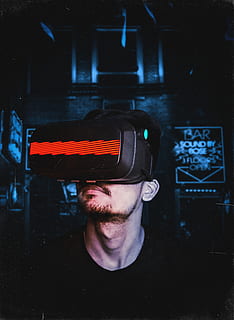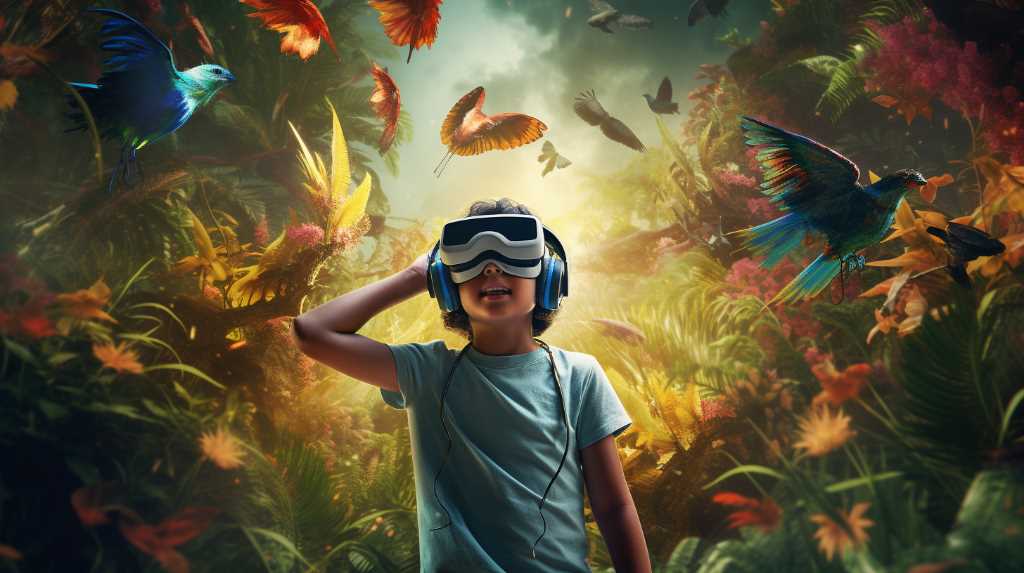Are you ready to revolutionize your education experience? Unlock the power of VR learning and immerse yourself in a whole new way of learning. With virtual reality, you can step into virtual classrooms, engage in interactive simulations, and even embark on virtual field trips.
This cutting-edge technology enhances student engagement and retention, bridging the gap between theory and practice. Get ready to embrace the future of education with immersive learning.
Key Takeaways
- VR technology enhances student engagement and retention.
- VR allows for a more engaging and interactive learning experience.
- VR brings history to life by allowing students to explore ancient civilizations.
- VR improves understanding and retention of information.
The Benefits of VR in Education
You can experience the benefits of VR in education through immersive virtual reality experiences. By using VR technology, you can transport yourself to different places and times, allowing for a more engaging and interactive learning experience. Imagine learning about ancient civilizations and being able to explore their cities and monuments firsthand. With VR, you can walk through the streets of Rome or visit the pyramids of Egypt, bringing history to life right in front of your eyes.
Not only does VR make learning more exciting, but it also enhances retention and understanding. When you actively participate in a virtual reality experience, your brain is fully engaged, making it easier to remember information. This hands-on approach to learning helps you grasp complex concepts and retain knowledge for a longer period of time.
Furthermore, VR in education offers a safe and controlled environment for students to practice skills that would otherwise be difficult or dangerous. For example, medical students can perform surgeries in a virtual operating room, allowing them to gain practical experience without putting real patients at risk. Similarly, aspiring pilots can practice flying in a virtual cockpit, improving their skills without the potential dangers of a real plane.
Immersive Learning Methods for Engaging Education
Immerse yourself in the world of virtual reality and explore the captivating learning methods that engage students in education. With the advancements in technology, educators are now harnessing the power of virtual reality (VR) to create immersive learning experiences that revolutionize the way students engage with educational content.
Imagine stepping into a virtual world where you can travel back in time to witness historical events or explore the depths of the ocean alongside marine creatures. Through VR, students can experience these scenarios firsthand, making learning more interactive and memorable. By actively participating in the learning process, students are more likely to retain information and develop a deeper understanding of the subject matter.
Moreover, VR provides a safe and controlled environment for students to practice real-world skills. For example, aspiring surgeons can simulate complex surgeries, allowing them to refine their techniques without any risk to patients. This hands-on approach not only enhances learning, but also boosts confidence and proficiency.
Furthermore, VR enables educators to cater to different learning styles and preferences. Visual learners can benefit from immersive visualizations, while kinesthetic learners can engage in interactive activities. By personalizing the learning experience, students are more motivated and actively involved in their education.

Virtual Classrooms: A New Era of Interactive Learning
Join the virtual classrooms to experience a multitude of interactive learning opportunities. In these digital spaces, you'll find a whole new world of education waiting to be explored.
Here are just a few reasons why virtual classrooms are revolutionizing the way we learn:
Immersive Experiences: Step into virtual reality (VR) and immerse yourself in realistic simulations. From exploring ancient civilizations to conducting virtual science experiments, you can truly live the subject matter.
Collaborative Learning: Connect with students from all over the globe and engage in collaborative projects. Work together, exchange ideas, and learn from each other's unique perspectives.
Personalized Education: Virtual classrooms offer tailored learning experiences that cater to your individual needs and interests. Get personalized feedback, access additional resources, and progress at your own pace.
Real-World Applications: Bring learning to life by applying knowledge in practical, real-world scenarios. Virtual classrooms allow you to practice skills, solve problems, and make decisions in a safe and controlled environment.
Educational Simulations: Bridging the Gap Between Theory and Practice
Educational simulations provide a unique opportunity for you to bridge the gap between theory and practice. By immersing yourself in realistic scenarios, you can enhance your practical learning and foster real-world application of the concepts you've learned.
These simulations allow you to actively engage with the material, gaining valuable hands-on experience that complements your theoretical knowledge.
Enhancing Practical Learning
You can take advantage of virtual reality to actively engage in practical learning and bridge the gap between theory and practice. With VR, you can immerse yourself in realistic simulations and acquire valuable skills through hands-on experiences.
Here are four reasons why VR learning can evoke a powerful emotional response:

Unforgettable Experiences: VR allows you to step into different environments and scenarios, creating memorable experiences that stay with you long after the lesson.
Empathy and Understanding: By embodying different perspectives, VR enhances empathy and understanding, fostering a deeper connection to the subject matter.
Confidence Building: VR provides a safe space to practice and make mistakes, boosting confidence and encouraging risk-taking.
Engaging Learning: The interactive nature of VR keeps you engaged, making learning enjoyable and increasing motivation to explore and discover.
Through VR, practical learning becomes more immersive, impactful, and emotionally compelling. So why not tap into this transformative technology and unlock the power of VR learning?
Fostering Real-World Application
By utilizing educational simulations, you can foster real-world application and bridge the gap between theory and practice. Educational simulations provide a virtual environment where you can apply what you've learned in a practical setting. These simulations allow you to engage in hands-on experiences and problem-solving scenarios that mimic real-life situations.
Through this immersive learning approach, you can gain a deeper understanding of concepts and develop critical thinking skills. Whether you're studying medicine, engineering, or business, simulations offer a safe space to make mistakes and learn from them.
They enable you to explore different outcomes and experiment with various strategies, preparing you for the challenges you may face in the real world.
VR Learning Tools: Enhancing Student Engagement and Retention
Get ready to dive into the world of VR learning and explore how it can enhance your engagement and retention as a student! Virtual Reality (VR) is revolutionizing the way we learn, making education more interactive, immersive, and exciting. With VR learning tools, you can step into virtual environments and experiences that bring your lessons to life. Here are four reasons why VR learning can have a powerful impact on your education:
Immersive Experiences: VR allows you to fully immerse yourself in educational scenarios, transporting you to places you've only read about. Whether you're exploring ancient civilizations or diving deep into the ocean, VR creates a sense of presence that makes learning truly unforgettable.

Active Participation: In VR, you're not just a passive observer but an active participant in your learning. You can interact with objects, solve problems, and engage in hands-on activities, promoting critical thinking and problem-solving skills.
Emotional Connection: VR learning evokes powerful emotions, making lessons more memorable. By experiencing historical events or empathizing with different perspectives, you develop a deeper understanding and emotional connection to the subject matter.
Individualized Learning: VR learning allows for personalized experiences tailored to your needs and learning style. You can learn at your own pace, revisit challenging concepts, and receive immediate feedback, enhancing your understanding and retention.
Virtual Field Trips: Bringing the World Into the Classroom
Immerse yourself in the wonders of the world as virtual field trips bring the classroom to life. Gone are the days of merely reading about far-off places or looking at static images in textbooks. Now, with the power of virtual reality (VR), students can explore the depths of the Amazon rainforest, walk the streets of ancient Rome, or dive into the Great Barrier Reef, all from the comfort of their own classroom.
Through virtual field trips, students can experience the sights and sounds of different locations, enhancing their understanding and engagement with the subject matter. Imagine standing on the top of Mount Everest, feeling the cold wind on your face and taking in the breathtaking view. Or imagine walking through the Louvre in Paris, surrounded by famous works of art that you can almost touch. These immersive experiences not only make learning more exciting and memorable, but they also allow for a deeper understanding and connection to the material.
Virtual field trips also provide access to places that may be otherwise inaccessible due to logistical or financial constraints. Students who may never have the opportunity to travel abroad can now visit famous landmarks, historical sites, and natural wonders through virtual reality. This technology has the power to level the playing field and ensure that all students have equal access to educational experiences.
In addition to expanding students' horizons, virtual field trips also offer practical benefits. They save time and money by eliminating the need for physical travel, and they can be easily integrated into existing lesson plans. Teachers can guide students through the virtual experiences, providing context, asking questions, and facilitating discussions. This interactive approach to learning fosters critical thinking skills and encourages students to explore and discover on their own.
However, it's important to note that virtual field trips shouldn't replace real-world experiences entirely. Nothing can truly replace the feeling of standing in a foreign land or interacting with locals. Virtual reality should be seen as a supplement to traditional field trips, offering a way to enhance and enrich the learning experience.
Revolutionizing the Educational Experience With Virtual Reality
Imagine a classroom where students are no longer confined to textbooks and lectures, but instead embark on interactive journeys that bring learning to life. With virtual reality, education is transformed into an immersive experience that captivates students' attention and ignites their curiosity.
From exploring ancient civilizations to conducting scientific experiments, virtual reality revolutionizes the educational experience by engaging students in a way that traditional methods simply can't match.

Enhanced Student Engagement
You'll experience higher levels of student engagement with our innovative virtual reality learning platform. Our platform is designed to captivate students' attention and make learning more interactive and immersive than ever before. Here are four reasons why our virtual reality learning platform will enhance student engagement:
Immersive Experiences: Students will be transported to different places and time periods, allowing them to explore and experience subjects firsthand.
Multi-Sensory Learning: Our platform stimulates multiple senses, making learning more engaging and memorable.
Personalized Learning: Students can customize their learning experience based on their individual interests and needs, fostering a sense of ownership and motivation.
Collaborative Learning: Our platform encourages collaboration and teamwork, enabling students to learn from and with their peers.
With our virtual reality learning platform, you'll create an educational experience that will captivate and inspire your students like never before.
Real-World Simulations
Take advantage of the article 'a' and revolutionize your educational experience with virtual reality by incorporating real-world simulations into your lessons. With virtual reality, you can transport yourself and your students to any location, whether it's exploring ancient civilizations, diving into the depths of the ocean, or even traveling through space.
By using real-world simulations, you can provide a hands-on and immersive learning experience that goes beyond the limitations of traditional textbooks and classrooms. Students can interact with their environment, solve problems, and gain a deeper understanding of complex concepts.
Imagine the excitement and engagement as they witness historical events unfold before their eyes or conduct experiments in a virtual laboratory. Real-world simulations in virtual reality have the power to transform education and create a dynamic, interactive learning environment that sparks curiosity and fosters critical thinking skills.
Accessible and Inclusive
With virtual reality, you can create an accessible and inclusive educational experience for all students. Imagine the possibilities!

- Step into historical events and feel the weight of history on your shoulders.
- Explore the deepest depths of the ocean and witness the beauty of marine life up close.
- Travel to distant planets and marvel at the wonders of the universe.
- Walk in someone else's shoes and gain empathy for different perspectives.
Virtual reality breaks down barriers and opens up a world of opportunities for students of all abilities. It allows for hands-on learning, engagement, and interaction like never before. By creating a virtual classroom, educators can cater to individual learning styles and provide an inclusive environment where every student can thrive.
Let's embrace this technological revolution and unlock the full potential of education for all.
Practical Tips for Implementing VR in Education
Get ready to revolutionize your classroom with these practical tips for implementing VR in education! Virtual reality (VR) technology has the potential to transform the way students learn by providing immersive and interactive experiences. By incorporating VR into your teaching strategies, you can create engaging and memorable lessons that capture your students' attention and enhance their understanding of complex concepts.
Firstly, consider the hardware and software requirements for VR implementation. Ensure that you have suitable VR headsets and compatible devices for your students to use. Familiarize yourself with different VR platforms and explore educational VR applications that align with your curriculum objectives.
Next, design VR experiences that align with your learning goals. Identify specific topics or subjects where VR can add value and create virtual environments that allow students to explore and interact with the content. Whether it's exploring the depths of the ocean or visiting historical landmarks, VR can transport your students to places they may not otherwise have the opportunity to visit.
To maximize the impact of VR in the classroom, incorporate it as a supplemental tool to existing teaching methods. VR should be used to enhance and complement traditional instruction rather than replace it entirely. Consider integrating VR experiences into group activities or project-based learning tasks, allowing students to collaborate and problem-solve in a virtual environment.
Lastly, assess student learning and gather feedback to measure the effectiveness of VR integration. Use formative assessments and student reflections to evaluate their engagement, understanding, and overall experience with VR. Adjust and refine your VR lessons based on this feedback to continually improve their educational value.
Recommended VR Resources for Educators and Students
Explore these highly recommended VR resources for educators and students to enhance your teaching and learning experiences. With the power of virtual reality (VR), you can take your classrooms to new heights and provide your students with immersive learning experiences that they'll never forget.
Here are four incredible VR resources that will revolutionize your educational journey:
Google Expeditions: Take your students on virtual field trips to explore the wonders of the world. From visiting ancient ruins to diving into the depths of the ocean, Google Expeditions allows you to bring the world to your classroom.

Nearpod VR: Engage your students with interactive VR lessons that cater to various subjects. Whether you want to explore the human body or embark on a journey through space, Nearpod VR offers a wide range of educational experiences.
Merge Cube: Transform your classroom into a magical world where students can manipulate 3D objects with their hands. Merge Cube blends physical and digital elements, allowing students to interact with virtual objects in a unique and captivating way.
Discovery VR: Ignite curiosity and spark a love for learning with Discovery VR. With a vast library of educational videos, students can explore the depths of the rainforest, witness historical events, and even go on thrilling adventures alongside experts in their field.
These VR resources will take your teaching and learning experiences to the next level, making education more engaging, immersive, and unforgettable.
Don't miss out on the incredible possibilities that VR has to offer!
Frequently Asked Questions
How Much Does VR Technology Cost for Educational Institutions?
The cost of VR technology for educational institutions can vary depending on the specific needs and requirements. It is recommended that you research and compare prices from different vendors to find the best fit for your budget.
Are There Any Potential Health Risks Associated With Using VR in Education?
There may be potential health risks associated with using VR in education. It's important to consider factors such as motion sickness, eye strain, and disorientation. Taking breaks and adjusting settings can help mitigate these risks.
What Are the Limitations of VR Technology in Terms of Subjects That Can Be Taught?
The limitations of VR technology in terms of subjects that can be taught vary. Some subjects, like science and history, lend themselves well to immersive experiences, while others, like language learning, may require additional tools.
How Do Teachers Receive Training on How to Use VR in the Classroom?
To learn how to use VR in the classroom, teachers receive training that familiarizes them with the technology and provides guidance on integrating it into their lessons effectively. They learn practical strategies and gain hands-on experience to enhance their teaching.
Are There Any Studies or Research That Show the Long-Term Impact of VR Learning on Student Performance?
There are studies and research that show the long-term impact of VR learning on student performance. They demonstrate improved engagement, retention, and understanding, leading to higher academic achievement and future success.

Conclusion
In conclusion, VR technology has the potential to revolutionize education by providing immersive learning experiences that engage students and enhance their retention of knowledge. Virtual classrooms, educational simulations, VR learning tools, and virtual field trips all offer interactive and dynamic ways for students to learn and explore.
By implementing VR in education, educators can create a more engaging and effective learning environment that prepares students for the future. Don't miss out on the opportunity to unlock the power of VR learning!

